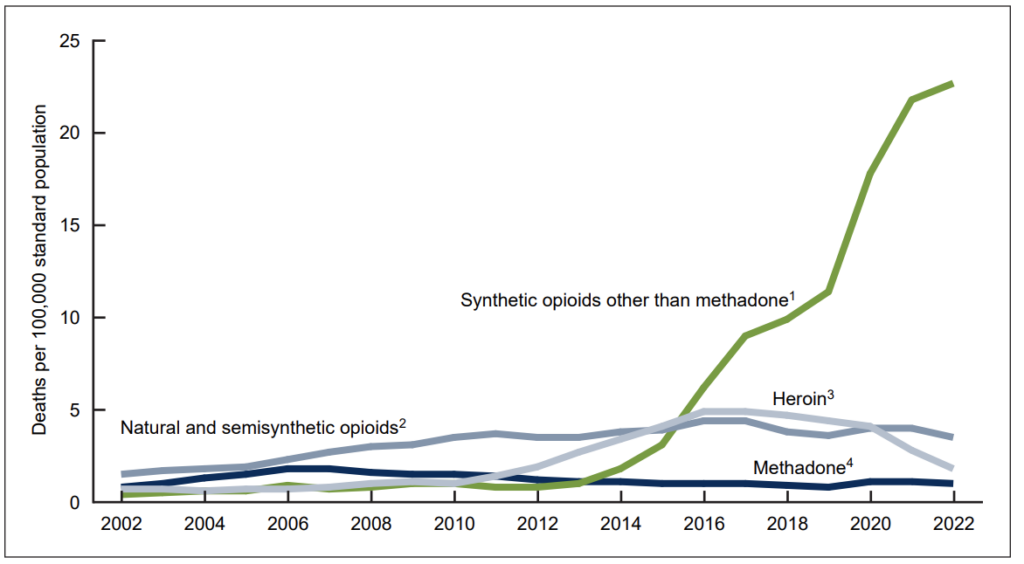The United States recorded 107,941 drug overdose deaths in 2022, according to final data from the Centers for Disease Control and Prevention. As expected, the figure represents the highest number of overdose deaths ever recorded in a 12-month period—but it’s also the first time in years that the annual mortality rate has plateaued, rather than continuing to rise sharply. The CDC released the National Center for Health Statistics data on March 21.
In 2020, the year with the biggest increase in overdose mortality compared to the year before, the death rate went up by 31 percent. From 2020 to 2021, the rate increased by 14 percent. In 2022, the CDC recorded an overdose mortality rate of 32.6 deaths per 100,000 people, which is a 0.006-percent increase from 2021.
A total of 1,147,004 overdose deaths have now been recorded since the CDC began tracking them in 1999.
In 2022, the only “significant” (but still small) decrease in overdose mortality was among non-Hispanic white people, though the data also showed a comparably slight decrease in mortality among those who identified as Native Hawaiian or Other Pacific Islander. For everyone else, the mortality rate went up.
Amid concerns of an escalating youth overdose crisis, deaths decreased among people under age 34—among people 35 and older, the rate increased. The highest rate of overdose deaths was among people in the 35-44 age bracket. The biggest increase compared to 2021 was among people over 65.
Compared to 2021, more deaths involved fentanyl, methamphetamine and/or cocaine. For deaths involving “semisynthetic opioids,” which generally refers to pharmaceutical analgesics like oxycodone, the rate decreased by 12.5 percent. Heroin-involved deaths, meanwhile, decreased by 35.7 percent. As fentanyl saturates the unregulated opioid supply, heroin has become harder to find.

In CDC death data, the terms “drug poisoning” and “drug overdose” are synonymous. This can be confusing because some states, like Texas, have moved toward recording fentanyl-caused death as “poisoning” on death certificates, rather than “overdose.” In the US, “poisoning” has lately been taken up by people seeking an alternative term for fentanyl-involved deaths of those they didn’t consider “addicts,” the implication being that some losses are more acceptable than others. “Fentanyl poisoning” has become the preferred term of the Drug Enforcement Administration.
Almost every time you hear either term (we’ll use “overdose” here) it’s going to be in reference to the opioid-involved overdose crisis, but in the context of CDC data they actually both refer to a category of deaths that is slightly broader. The overdose deaths we associate with the current crisis are “accidental” or “unintentional” (these terms are used interchangeably), but the annual CDC tallies also reflect overdose deaths that were not considered accidental. Of the overdose deaths recorded in 2022, around 8,300 (7.6 percent) were deemed suicide, homicide or undetermined.
In a big-picture sense, the thing to remember about drug death data is that by the time it makes it to the CDC and then the media, it’s almost completely divorced from whatever original context would have made it useful. Deaths that “involved” a given drug don’t always mean they were “caused” by that drug, which especially skews public perception of overdose deaths “caused” by stimulants. Often the only conclusion we can safely draw is that a person had some of that drug in their system at the time that they died, which is what the CDC report is somewhat obliquely referencing here:
“Several factors related to death investigation and reporting may affect measurement of death rates involving specific drugs. At autopsy, the substances tested for and the circumstances under which the toxicology tests are performed vary by jurisdiction. This variability is more likely to affect substance-specific death rates than the overall drug overdose death rate.”
Top image via Washington State Health Care Authority. Inset graphic via Centers for Disease Control and Prevention.





Show Comments